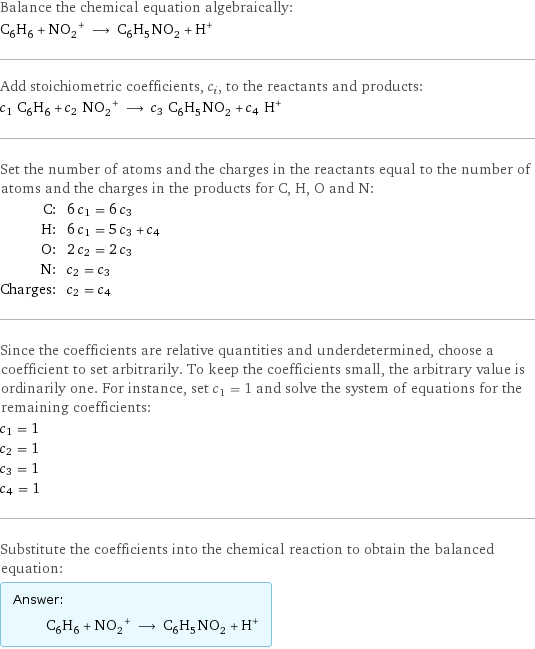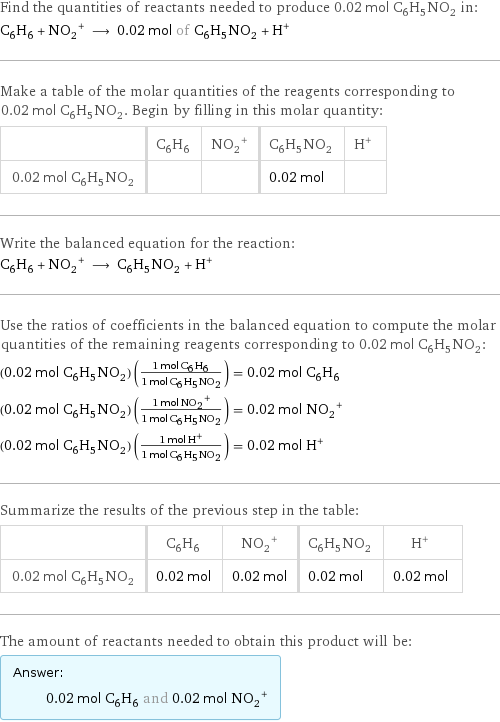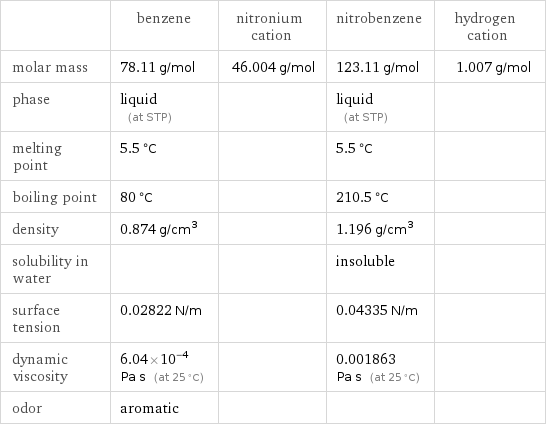Input interpretation

C_6H_6 benzene + (NO_2)^+ nitronium cation ⟶ 0.0200 mol of C_6H_5NO_2 nitrobenzene + H^+ hydrogen cation
Balanced equation

Balance the chemical equation algebraically: C_6H_6 + (NO_2)^+ ⟶ C_6H_5NO_2 + H^+ Add stoichiometric coefficients, c_i, to the reactants and products: c_1 C_6H_6 + c_2 (NO_2)^+ ⟶ c_3 C_6H_5NO_2 + c_4 H^+ Set the number of atoms and the charges in the reactants equal to the number of atoms and the charges in the products for C, H, O and N: C: | 6 c_1 = 6 c_3 H: | 6 c_1 = 5 c_3 + c_4 O: | 2 c_2 = 2 c_3 N: | c_2 = c_3 Charges: | c_2 = c_4 Since the coefficients are relative quantities and underdetermined, choose a coefficient to set arbitrarily. To keep the coefficients small, the arbitrary value is ordinarily one. For instance, set c_1 = 1 and solve the system of equations for the remaining coefficients: c_1 = 1 c_2 = 1 c_3 = 1 c_4 = 1 Substitute the coefficients into the chemical reaction to obtain the balanced equation: Answer: | | C_6H_6 + (NO_2)^+ ⟶ C_6H_5NO_2 + H^+
Stoichiometry

Find the quantities of reactants needed to produce 0.02 mol C_6H_5NO_2 in: C_6H_6 + (NO_2)^+ ⟶ 0.02 mol of C_6H_5NO_2 + H^+ Make a table of the molar quantities of the reagents corresponding to 0.02 mol C_6H_5NO_2. Begin by filling in this molar quantity: | C_6H_6 | (NO_2)^+ | C_6H_5NO_2 | H^+ 0.02 mol C_6H_5NO_2 | | | 0.02 mol | Write the balanced equation for the reaction: C_6H_6 + (NO_2)^+ ⟶ C_6H_5NO_2 + H^+ Use the ratios of coefficients in the balanced equation to compute the molar quantities of the remaining reagents corresponding to 0.02 mol C_6H_5NO_2: (0.02 mol C_6H_5NO_2) ((1 mol C_6H_6)/(1 mol C_6H_5NO_2)) = 0.02 mol C_6H_6 (0.02 mol C_6H_5NO_2) ((1 mol (NO_2)^+)/(1 mol C_6H_5NO_2)) = 0.02 mol (NO_2)^+ (0.02 mol C_6H_5NO_2) ((1 mol H^+)/(1 mol C_6H_5NO_2)) = 0.02 mol H^+ Summarize the results of the previous step in the table: | C_6H_6 | (NO_2)^+ | C_6H_5NO_2 | H^+ 0.02 mol C_6H_5NO_2 | 0.02 mol | 0.02 mol | 0.02 mol | 0.02 mol The amount of reactants needed to obtain this product will be: Answer: | | 0.02 mol C_6H_6 and 0.02 mol (NO_2)^+
Structures

+ ⟶ +
Names

benzene + nitronium cation ⟶ nitrobenzene + hydrogen cation
Equilibrium constant
![Construct the equilibrium constant, K, expression for: C_6H_6 + (NO_2)^+ ⟶ C_6H_5NO_2 + H^+ Plan: • Balance the chemical equation. • Determine the stoichiometric numbers. • Assemble the activity expression for each chemical species. • Use the activity expressions to build the equilibrium constant expression. Write the balanced chemical equation: C_6H_6 + (NO_2)^+ ⟶ C_6H_5NO_2 + H^+ Assign stoichiometric numbers, ν_i, using the stoichiometric coefficients, c_i, from the balanced chemical equation in the following manner: ν_i = -c_i for reactants and ν_i = c_i for products: chemical species | c_i | ν_i C_6H_6 | 1 | -1 (NO_2)^+ | 1 | -1 C_6H_5NO_2 | 1 | 1 H^+ | 1 | 1 Assemble the activity expressions accounting for the state of matter and ν_i: chemical species | c_i | ν_i | activity expression C_6H_6 | 1 | -1 | ([C6H6])^(-1) (NO_2)^+ | 1 | -1 | ([NO2+1])^(-1) C_6H_5NO_2 | 1 | 1 | [C6H5NO2] H^+ | 1 | 1 | [H+1] The equilibrium constant symbol in the concentration basis is: K_c Mulitply the activity expressions to arrive at the K_c expression: Answer: | | K_c = ([C6H6])^(-1) ([NO2+1])^(-1) [C6H5NO2] [H+1] = ([C6H5NO2] [H+1])/([C6H6] [NO2+1])](../image_source/0db5b2baffc1d7bb0d64c4aa55a9fd9d.png)
Construct the equilibrium constant, K, expression for: C_6H_6 + (NO_2)^+ ⟶ C_6H_5NO_2 + H^+ Plan: • Balance the chemical equation. • Determine the stoichiometric numbers. • Assemble the activity expression for each chemical species. • Use the activity expressions to build the equilibrium constant expression. Write the balanced chemical equation: C_6H_6 + (NO_2)^+ ⟶ C_6H_5NO_2 + H^+ Assign stoichiometric numbers, ν_i, using the stoichiometric coefficients, c_i, from the balanced chemical equation in the following manner: ν_i = -c_i for reactants and ν_i = c_i for products: chemical species | c_i | ν_i C_6H_6 | 1 | -1 (NO_2)^+ | 1 | -1 C_6H_5NO_2 | 1 | 1 H^+ | 1 | 1 Assemble the activity expressions accounting for the state of matter and ν_i: chemical species | c_i | ν_i | activity expression C_6H_6 | 1 | -1 | ([C6H6])^(-1) (NO_2)^+ | 1 | -1 | ([NO2+1])^(-1) C_6H_5NO_2 | 1 | 1 | [C6H5NO2] H^+ | 1 | 1 | [H+1] The equilibrium constant symbol in the concentration basis is: K_c Mulitply the activity expressions to arrive at the K_c expression: Answer: | | K_c = ([C6H6])^(-1) ([NO2+1])^(-1) [C6H5NO2] [H+1] = ([C6H5NO2] [H+1])/([C6H6] [NO2+1])
Rate of reaction
![Construct the rate of reaction expression for: C_6H_6 + (NO_2)^+ ⟶ C_6H_5NO_2 + H^+ Plan: • Balance the chemical equation. • Determine the stoichiometric numbers. • Assemble the rate term for each chemical species. • Write the rate of reaction expression. Write the balanced chemical equation: C_6H_6 + (NO_2)^+ ⟶ C_6H_5NO_2 + H^+ Assign stoichiometric numbers, ν_i, using the stoichiometric coefficients, c_i, from the balanced chemical equation in the following manner: ν_i = -c_i for reactants and ν_i = c_i for products: chemical species | c_i | ν_i C_6H_6 | 1 | -1 (NO_2)^+ | 1 | -1 C_6H_5NO_2 | 1 | 1 H^+ | 1 | 1 The rate term for each chemical species, B_i, is 1/ν_i(Δ[B_i])/(Δt) where [B_i] is the amount concentration and t is time: chemical species | c_i | ν_i | rate term C_6H_6 | 1 | -1 | -(Δ[C6H6])/(Δt) (NO_2)^+ | 1 | -1 | -(Δ[NO2+1])/(Δt) C_6H_5NO_2 | 1 | 1 | (Δ[C6H5NO2])/(Δt) H^+ | 1 | 1 | (Δ[H+1])/(Δt) (for infinitesimal rate of change, replace Δ with d) Set the rate terms equal to each other to arrive at the rate expression: Answer: | | rate = -(Δ[C6H6])/(Δt) = -(Δ[NO2+1])/(Δt) = (Δ[C6H5NO2])/(Δt) = (Δ[H+1])/(Δt) (assuming constant volume and no accumulation of intermediates or side products)](../image_source/25b2475c549cefe8cf1835e2eb2e3f5e.png)
Construct the rate of reaction expression for: C_6H_6 + (NO_2)^+ ⟶ C_6H_5NO_2 + H^+ Plan: • Balance the chemical equation. • Determine the stoichiometric numbers. • Assemble the rate term for each chemical species. • Write the rate of reaction expression. Write the balanced chemical equation: C_6H_6 + (NO_2)^+ ⟶ C_6H_5NO_2 + H^+ Assign stoichiometric numbers, ν_i, using the stoichiometric coefficients, c_i, from the balanced chemical equation in the following manner: ν_i = -c_i for reactants and ν_i = c_i for products: chemical species | c_i | ν_i C_6H_6 | 1 | -1 (NO_2)^+ | 1 | -1 C_6H_5NO_2 | 1 | 1 H^+ | 1 | 1 The rate term for each chemical species, B_i, is 1/ν_i(Δ[B_i])/(Δt) where [B_i] is the amount concentration and t is time: chemical species | c_i | ν_i | rate term C_6H_6 | 1 | -1 | -(Δ[C6H6])/(Δt) (NO_2)^+ | 1 | -1 | -(Δ[NO2+1])/(Δt) C_6H_5NO_2 | 1 | 1 | (Δ[C6H5NO2])/(Δt) H^+ | 1 | 1 | (Δ[H+1])/(Δt) (for infinitesimal rate of change, replace Δ with d) Set the rate terms equal to each other to arrive at the rate expression: Answer: | | rate = -(Δ[C6H6])/(Δt) = -(Δ[NO2+1])/(Δt) = (Δ[C6H5NO2])/(Δt) = (Δ[H+1])/(Δt) (assuming constant volume and no accumulation of intermediates or side products)
Chemical names and formulas

| benzene | nitronium cation | nitrobenzene | hydrogen cation formula | C_6H_6 | (NO_2)^+ | C_6H_5NO_2 | H^+ name | benzene | nitronium cation | nitrobenzene | hydrogen cation
Substance properties

| benzene | nitronium cation | nitrobenzene | hydrogen cation molar mass | 78.11 g/mol | 46.004 g/mol | 123.11 g/mol | 1.007 g/mol phase | liquid (at STP) | | liquid (at STP) | melting point | 5.5 °C | | 5.5 °C | boiling point | 80 °C | | 210.5 °C | density | 0.874 g/cm^3 | | 1.196 g/cm^3 | solubility in water | | | insoluble | surface tension | 0.02822 N/m | | 0.04335 N/m | dynamic viscosity | 6.04×10^-4 Pa s (at 25 °C) | | 0.001863 Pa s (at 25 °C) | odor | aromatic | | |
Units
